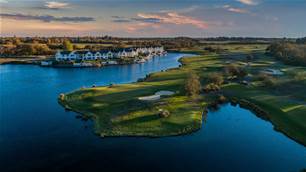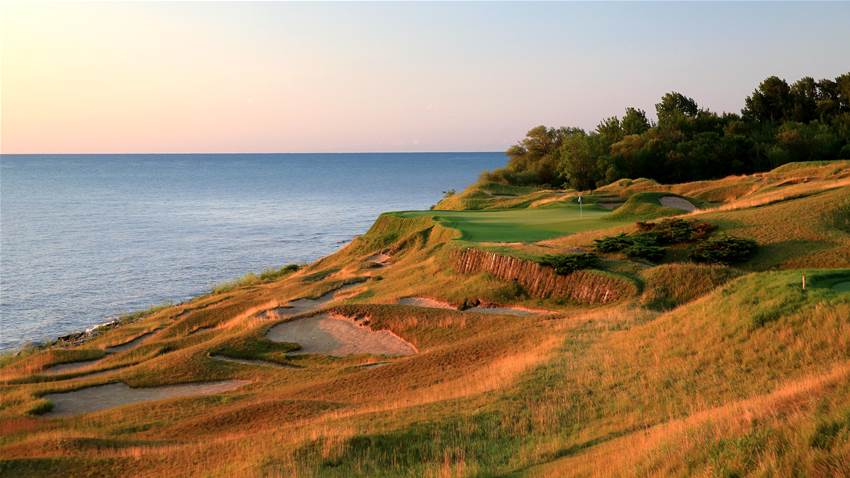Golf was invented as a walking game. But in the modern age of course construction where layouts are longer and cover expansive areas across sometimes hilly topography, they can be a difficult slog. Here’s 15 of the toughest for walking golfers.
8 HAMILTON ISLAND – Queensland, Australia
The Hamilton Island course is actually found on neighbouring Dent Island – a tropical tree and scrub-covered monolith that rises steeply, to about 105 metres at its highest point, from the aquamarine waters of the Coral Sea below.
The club can only be reached by ferry from the Hamilton Island marina and as you cross the passage there is little to suggest a golf course lies on the ridges and cliff-tops high above. It is dramatic, rugged terrain that defies belief that Peter Thomson and Ross Perrett were actually able to design a playable course. Carts are included in your green fee.
9 BETHPAGE STATE PARK (Black course) – New York, USA
Not only is this A.W Tillinghast course a beast to play (hence the sign warning players of its difficulty) it is a tough walk covering 7,465 yards from the tips.
Bethpage (pictured) is a walking-only course that is laid across terrain with some substantial elevation changes throughout, with perhaps the toughest climb coming in the final 180 yards approaching the 15th green, which is 25 metres above the fairway.
10 NATADOLA BAY – Coral Coast, Fiji
From the moment you play down to the 1st green of the Vijay Singh-designed home of the Fiji International, it is in the back of your mind that you need to climb back up the hill to reach the clubhouse.
The fact is, 14 holes of the seaside layout wind across undulating terrain while four inland holes cover dramatic topography better suited to mountain goats but home to some spectacular golf. For example, the fairway of the par-5 5th hole lies more than 50m metres below the tee and then the climb to the green is all uphill.

11 OLD HEAD LINKS – County Cork, Ireland
What sets Old Head apart from the other courses showcased here is the walking difficulty of this course is not created by what is under your feet but more what Mother Nature can produce. The links is laid out on a diamond-shaped promontory jutting more than three kilometres into the Atlantic Ocean. The elevation changes are not all that dramatic but the wind can make the trek here absolutely brutal. If it’s blowing hard, you have the option of taking a cart.

12 CARNE GOLF LINKS – County Mayo, Ireland
Remote and spectacular, Carne is set among exposed rugged dunes on the Atlantic coast in north-west Ireland. Not only is the terrain often dramatic as it rises and falls over the dunes, it is rare to play here without it being windy.
Carne’s toughest cardio workout comes at the final hole. Having traversed dunes for hours the approach to the final green on the 495-metre par-5 is all uphill – the payoff is the view of Blacksod Bay once you reach the green.

13 THE NATIONAL (Old course) – Victoria, Australia
Designed by Robert Trent Jones Jnr, the Old course at The National Golf Club covers terrain that ranges from wildly undulating to downright hilly. This is not a long course but the only flat spots you will find during a round here can be found on each of the tees.
If you have the fitness level to walk this layout, go for it, and you will likely have more time to take in the incredible views as you stride along. If you’re not looking for a heavy cardio workout, we recommend you take a cart.

14 NULLARBOR LINKS – South and Western Australia, Australia
There is 1,365 kilometres between the 1st tee at Ceduna Golf Club in South Australia, across the Nullarbor Plain, to the 18th green at Kalgoorlie Golf Club. Enough said. You would be mad to walk this one.
15 KAURI CLIFFS – Bay of Islands, New Zealand
Kauri Cliffs meanders through 800 acres of fern forest and across the edges of cliff tops on some of the most dramatic golf topography in New Zealand.
acres of fern forest and across the edges of cliff tops on some of the most dramatic golf topography in New Zealand.
RIGHT: Kauri Cliffs in New Zealand. PHOTO: Getty Images.
The vast distances from greens to the next tee as well as the steep elevation changes makes walking here only for the fittest of golfers. Carts are available but if you want to really challenge your ability to endure the mental and physical test Kauri Cliffs offers, by all means cover it on foot. The spectacular views from this escarpment high above the ocean will probably take your mind off the difficulty of the trek.
Related Articles

The Aussies at the U.S Women’s Open

Review: Clearwater Golf Club













